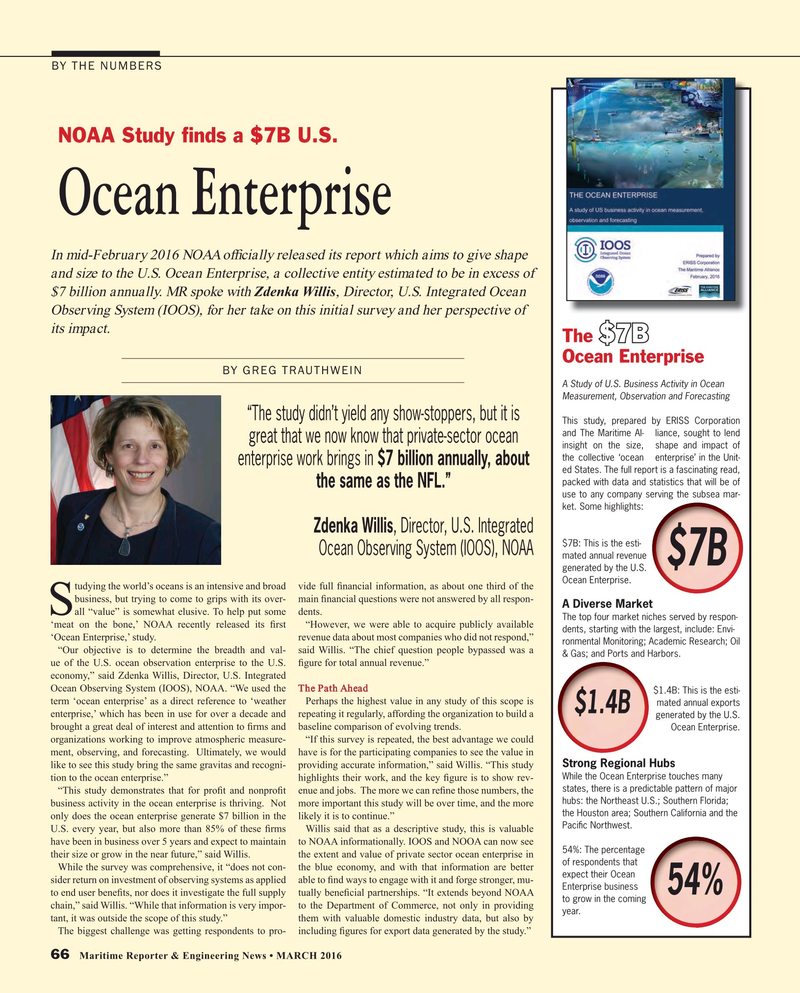
Page 66: of Maritime Reporter Magazine (March 2016)
Green Marine Technology
Read this page in Pdf, Flash or Html5 edition of March 2016 Maritime Reporter Magazine
BY THE NUMBERS
NOAA Study ? nds a $7B U.S.
Ocean Enterprise
In mid-February 2016 NOAA of? cially released its report which aims to give shape and size to the U.S. Ocean Enterprise, a collective entity estimated to be in excess of $7 billion annually. MR spoke with Zdenka Willis, Director, U.S. Integrated Ocean
Observing System (IOOS), for her take on this initial survey and her perspective of its impact.
The $7B
Ocean Enterprise
BY GREG TRAUTHWEIN
A Study of U.S. Business Activity in Ocean
Measurement, Observation and Forecasting “The study didn’t yield any show-stoppers, but it is
This study, prepared by ERISS Corporation and The Maritime Al-liance, sought to lend great that we now know that private-sector ocean insight on the size, shape and impact of the collective ‘ocean enterprise’ in the Unit- enterprise work brings in $7 billion annually, about ed States. The full report is a fascinating read, packed with data and statistics that will be of the same as the NFL.” use to any company serving the subsea mar- ket. Some highlights:
Zdenka Willis, Director, U.S. Integrated $7B: This is the esti-
Ocean Observing System (IOOS), NOAA mated annual revenue $7B generated by the U.S.
Ocean Enterprise.
tudying the world’s oceans is an intensive and broad vide full ? nancial information, as about one third of the business, but trying to come to grips with its over- main ? nancial questions were not answered by all respon-
A Diverse Market
Sall “value” is somewhat elusive. To help put some dents.
The top four market niches served by respon- ‘meat on the bone,’ NOAA recently released its ? rst “However, we were able to acquire publicly available dents, starting with the largest, include: Envi- ‘Ocean Enterprise,’ study. revenue data about most companies who did not respond,” ronmental Monitoring; Academic Research; Oil “Our objective is to determine the breadth and val- said Willis. “The chief question people bypassed was a & Gas; and Ports and Harbors.
ue of the U.S. ocean observation enterprise to the U.S. ? gure for total annual revenue.” economy,” said Zdenka Willis, Director, U.S. Integrated
Ocean Observing System (IOOS), NOAA. “We used the The Path Ahead $1.4B: This is the esti- term ‘ocean enterprise’ as a direct reference to ‘weather Perhaps the highest value in any study of this scope is mated annual exports $1.4B enterprise,’ which has been in use for over a decade and repeating it regularly, affording the organization to build a generated by the U.S. brought a great deal of interest and attention to ? rms and baseline comparison of evolving trends.
Ocean Enterprise.
organizations working to improve atmospheric measure- “If this survey is repeated, the best advantage we could ment, observing, and forecasting. Ultimately, we would have is for the participating companies to see the value in
Strong Regional Hubs like to see this study bring the same gravitas and recogni- providing accurate information,” said Willis. “This study
While the Ocean Enterprise touches many tion to the ocean enterprise.” highlights their work, and the key ? gure is to show rev- states, there is a predictable pattern of major “This study demonstrates that for pro? t and nonpro? t enue and jobs. The more we can re? ne those numbers, the hubs: the Northeast U.S.; Southern Florida; business activity in the ocean enterprise is thriving. Not more important this study will be over time, and the more the Houston area; Southern California and the only does the ocean enterprise generate $7 billion in the likely it is to continue.”
Paci? c Northwest.
U.S. every year, but also more than 85% of these ? rms Willis said that as a descriptive study, this is valuable have been in business over 5 years and expect to maintain to NOAA informationally. IOOS and NOOA can now see 54%: The percentage their size or grow in the near future,” said Willis. the extent and value of private sector ocean enterprise in of respondents that
While the survey was comprehensive, it “does not con- the blue economy, and with that information are better expect their Ocean sider return on investment of observing systems as applied able to ? nd ways to engage with it and forge stronger, mu-
Enterprise business 54% to end user bene? ts, nor does it investigate the full supply tually bene? cial partnerships. “It extends beyond NOAA to grow in the coming chain,” said Willis. “While that information is very impor- to the Department of Commerce, not only in providing year.
tant, it was outside the scope of this study.” them with valuable domestic industry data, but also by
The biggest challenge was getting respondents to pro- including ? gures for export data generated by the study.” 66 Maritime Reporter & Engineering News • MARCH 2016
MR #3 (62-69).indd 66 3/3/2016 10:29:19 AM

 65
65

 67
67
